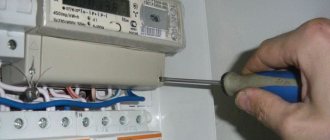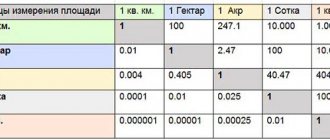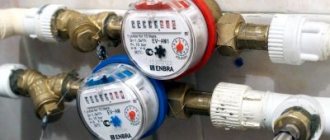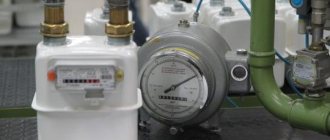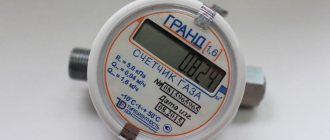05/08/2020 2,131 Counters
Author:Ivan
Any metering device, including a meter, tends to wear out over long periods of use. As a result, the device may display incorrect data during use. To prevent this, it is necessary to observe the verification interval of the electric meter.
[Hide]
What is verification of electric meters?
Any model of electricity metering equipment operates from the moment of installation until complete shutdown. The meter allows you to find out exactly how much electricity a private house or apartment consumes. But the accuracy with which various types of metering devices allow readings to be determined decreases over time as a result of natural wear and tear. Accordingly, such devices are subject to regular verification or diagnostics. This procedure is performed repeatedly, with a specific time interval and frequency.
What is MPI and is it necessary to verify electricity meters by law?
Inter-verification period (ICP) is a period of time after which the consumer needs to check the electric meter. If this requirement is ignored, the IPU goes into the “non-working” category, and the readings transmitted from it cannot be accepted for settlement transactions.
Each type of device has a separate interval within which the information is recognized by the power supply organization as relevant. With regard to resource consumption, verification in apartment buildings and private households, it is necessary to rely on the following regulations - federal laws No. 102 and No. 261.
However, from June 1, 2020, premises owners are exempt from the need to:
- use IPU;
- transmit information about metering devices when they fail;
- install equipment.
Due to its malfunction or the end of the inter-verification period, the RSO or service company is obliged to restore the resource supply by installing a new device.
Watch the video: “What to do if the verification period for the electric meter has expired. How to avoid fines."
Do new electric meters need to be verified?
It is not necessary to test only store-bought energy monitoring devices. Additional verification before installation and commissioning is not required. This is due to the fact that after manufacturing the equipment goes through all the necessary diagnostic stages. The relevant information is indicated in the technical data sheet for the metering device. But there is one exception to this nuance.
If the device has been in stock for a long time, it is recommended to check it before using it directly. For three-phase equipment, the duration of storage in the warehouse will be no more than one year from the date of production. In the case of single-phase devices, this figure is two years. If the time period is longer, then the energy meter’s shelf life is considered expired, and accordingly, equipment verification is required.
The fact is that the quality of functioning of the components and mechanisms of the meters is influenced by the storage conditions of the equipment. In practice, they are often violated; accordingly, the manufacturer of the metering device is no longer responsible for the accuracy of the meter readings. As a rule, trading companies that sell energy meters take this feature into account. Therefore, the purchase of equipment is usually carried out in small quantities so that the shelf life of the products does not exceed the norm.
The TyumenTime channel spoke in more detail about the need to test the metering device.
What to do if the verification period has expired
If the subscriber is absolutely sure that the verification period has expired and the time has expired, you should still contact the service center.
If the time for verification has been exhausted, but the device continues to be used, the subscriber will be responsible for this, not the energy sector. The longer the period of operation without verification, the greater the fine may be. Energy companies can prove in court that the device is faulty or inaccurate and recover significant funds from the negligent subscriber.
Types of verifications
There are several types of diagnostics of electrical equipment. Each type of verification is carried out at a certain time and under specific conditions.
Primary
It is carried out during the production of the metering device at the enterprise. This verification can be carried out when importing a product into the country if it was manufactured abroad. The main purpose is to determine the performance of the device as a whole. When diagnosing, a specialist compares the permissible error range with the actual one; this information, along with the date, is indicated in the technical passport.
Periodic
Such verification is carried out after a certain number of years of operation or storage of the equipment. It is carried out by representatives of the relevant organization of the metrological center. The purpose of this verification is to determine the amount of wear on the energy meter, as well as the possibility of issuing information with a specific degree of error.
Extraordinary
Performed before periodic diagnostics are due for various reasons:
- as a result of the need to replace equipment;
- when repairing the device;
- due to the loss of technical documentation for the energy meter;
- as a result of errors in readings if the homeowner has doubts about this.
The UTVNeft channel spoke about the nuances of checking metering devices.
Electric meter verification procedure
The verification period for the electricity meter is controlled by the owner of the apartment or private house. The obligated citizen must independently agree on the date of transfer of the device for diagnostics and deliver the IPU to the address of the metrological center. However, at the legislative level, conducting verification without removal is an acceptable procedure if the contractor has accreditation.
Step No. 1: Analysis of the correct connection of the electric meter
The use of a control device depends on the type of IPU and the number of phases. On the diagram this can be reflected as two connected inputs - zero and phase, as well as the point of connection with the load circuit.
The controller can diagnose problems with the electric meter by identifying additional sources of connection to the network. In the second case, suspicion may be caused by a violation of the connection sequence.
Deviations from the norm are grounds for additional verification, since such cases often indicate theft of resources through unauthorized connection. The correctness of the connected individual energy consumption device is carried out by simple inspection.
Step #2: Self-propelled research
The concept of “self-propelled” meter means circumstances under which the device disk rotates without additional load, i.e., on its own and at the same time all electrical appliances are de-energized. After turning on all the diverter automation, the controller observes the movement of the mechanism for 7-10 minutes.
If the device is working properly, then rotation will not occur, and the indicator will not show more than one pulse. In the opposite situation and a flashing sensor, the procedure ends with re-verification or installation of a new IPU.
Step #3: Gear Ratio
The gear ratio is set on the external panel of the electric meter. The coefficient provides information to the consumer and the RSO about the number of revolutions or blinks - the type of reading depends on the type of device.
Based on the rotation of the disk or electronic indicator, the consumed resource is calculated. In other words, these figures act as indications for calculating electricity - 1 kilowatt is equal to the approved tariff in the region.
Step #4: Establishing the error
Another necessary stage of conducting an inter-interval check of the electric meter is error diagnosis. The event is conditioned by establishing the correctness of the transmitted readings.
Step #5. Detection of meter magnetization
A pressing question for consumers is how often the electric meter is checked for magnetization. The topic is of interest to those property owners who have an old-style disk device installed. The new generation of IPUs are created on the basis of induction and have a protective seal that changes color when interacting with a magnet. Verifications of this type are required by the RSO to be carried out no more than once every six months.
An analysis of the magnetization of an individual consumption device can be carried out using a regular needle - if it is attracted to the equipment, then, therefore, the IPU has a strong magnetic field. It is noteworthy that such circumstances work both to the consumer’s advantage and to the disadvantage. That is, prohibited devices will not slow down, but, on the contrary, will accelerate the rotation of the disk, which means the owner will pay more.
Verification period
The timing of verification of electricity meters depends on the specifics of the procedure, i.e. whether the IPU needs to be removed or not. In the first case, a thorough diagnosis and issuance of a result on the possibility of operation will be required. This procedure can take several hours or 2-3 days.
If the inter-verification analysis does not require dismantling the electric meter, then the defining parameters are:
- diagnostics of the nominal voltage in the network - takes about 15-20 minutes;
- checking the fact of “self-propelled” – this will take 10-20 minutes;
- 10 min. an inspection is performed to ensure that there are no physical defects on the IPU;
- additional time is spent completing the report on a special form and sealing the meter.
Calibration interval of mechanical and electronic meters
Depending on the type of equipment, the time period for diagnosing energy meters will differ. It is important to observe the calibration interval of the electric meter and take into account not only the type, but also the type of device - mechanical or electronic.
Single-phase meters
The table for the frequency of verification of induction devices is compiled taking into account technical parameters.
| Type of equipment | Rated current value | Number of revolutions per 1 kilowatt per hour | Number of digits on the counting mechanism | Accuracy class | Calibration interval | Device Note |
| SO-1 | 5 | 2500 | 3 | 2,5 | 8 | No longer produced |
| SO-1 | 10 | 1250 | 4 | 2,5 | 8 | — |
| SO-1 | 10–40 | 600 | 4 | 2,5 | 16 | Manufactured since 1995 |
| SO-193 | 10–40 | 600 | 5 | 2,5 | 16 | — |
| SO-2 | 10 | 600 | 5 | 2,5 | 16 | VZET |
| SO-2 | 10 | 650 | 4 | 2,5 | 16 | — |
| SO-2 | 10 | 750 | 4 | 2,5 | 16 | — |
| SO-2 | 10 | 625 | 4 | 2,5 | 16 | — |
| SO-2 | 5 | 1250 | 4 | 2,5 | 16 | — |
| SO-2(60) | 10 | 750 | 4 | 2,5 | 16 | MZEP |
| SO-2(60) | 5 | 1250 | 4 | 2,5 | 16 | — |
| SO-2M | 10 | 640 | 4 | 2,5 | 16 | VZET |
| SO-2M | 5 | 1280 | 4 | 2,5 | 16 | — |
| SO-2M2 | 10–30 | 640 | 4 | 2,5 | 16 | — |
| SO-2M2 | 5–15 | 1280 | 4 | 2,5 | 16 | — |
| SO-2MT | 10–30 | 640 | 4 | 2,5 | 16 | — |
| SO-2MT3 | 10–30 | 640 | 4 | 2,5 | 16 | — |
| SO-5 | 5–15 | 1250 | 4 | 2,5 | 16 | — |
| SO-505 | 10–40 | 600 | 5 | 2 | 16 | — |
| SO-50 | 10–40 | 625 | 4 | 2,5 | 16 | — |
| SO-5U | 10–30 | 625 | 4 | 2,5 | 16 | — |
| SO-I445 | 10–40 | 440 | 5 | 2 | 16 | — |
| SO-I446 | 10–34 | 600 | 5 | 2,5 | 16 | — |
| SO-I446 | 5–17 | 1200 | 4 | 2,5 | 16 | — |
| SO-I446 | 5–20 | 1200 | 4 | 2,5 | 16 | — |
| SO-I446M | 10–40 | 600 | 5 | 2,5 | 16 | — |
| SO-I449 | 10–40 | 210 | 5 | 2 | 16 | — |
| SO-I449M | 10–60 | 200 | 5 | 2 | 16 | — |
| SO-I449M1-1 | 10–40 | 400 | 5 | 2 | 16 | — |
| SO-I449T | 10–40 | 210 | 5 | 2 | 16 | — |
| SO-I449MT | 10–60 | 200 | 5 | 2 | 16 | — |
| SO-EE6705 | 10–40 | 450 | 4 | 2 | 16 | LEMZ |
| SO-EE6705 | 10–40 | 400 | 5 | 2 | 16 | — |
For other types of single-phase induction devices, the verification interval will be 16 years, regardless of the accuracy class and the number of digits on the counting mechanism.
The frequency of diagnostics for electronic equipment is slightly different.
| Device type | Rated current parameter | Number of revolutions per 1 kW/h | Number of digits on the reading mechanism | Accuracy class | Inter-verification frequency | Note |
| TsE6807A-1 | 5–50 | 500 | 5 | 2 | 6 | METZ |
| TsE6807A-2 | 5–50 | 500 | 5 | 2 | 6 | METZ |
| Two-tariff equipment SEO-1 | 10–50 | 57600 | 5 | 2 | 6 | — |
| SO-F663 | 5–50 | 100 | 5 | 2 | 5 | Not produced |
| SOEB-1 | 10–50 | 720 | 5 | 2 | 6 | BEMZ |
| А100D1B | 10 (60) | 1000 | LCD | 1 | 16 | JV "ABBVEI" |
Three-phase meters
Table of frequency of verification of induction type energy meters in accordance with technical parameters.
| Type of equipment | Rated current value | Number of revolutions per kilowatt per hour | Number of digits on the reader | Accuracy class | Inter-verification frequency | Note |
| SA4U-I672M | 3×5 | 450 | 4 (5) | 2 | 4 | LEMZ |
| SA4-I672M | 3×10 | 225 | 4 | 2 | 8 | LEMZ 1, 2, 3 |
| SA4-I678 | 3×20–50 | 100 | 5 | 2 | 8 | 1, 2, 3 |
| SAZU-M670M | 3×5 | 450 | 4 | 2 | 4 | No longer produced |
| SA4U-T4 | 3×5 | 750 | 4 | 2 | 4 | — |
| SR4U-I673M | 3×5 | 450 | 4 | 2 | 4 | LEMZ |
| SA4-I6P | 3×10-60 | 100 | 5 | 2 | 8 | — |
| T31-F | 3×10 (60) | 75 | 6 | 2 | 8 | — |
| HN4-CA4 | 3×25–50 | 120 | 5 | 3 | 8 | — |
| DN-4 | 3x5–25 | 300 | 5 | 2 | 8 | Produced in Hungary |
| А1Т-4-0000Т | 5×24 | — | 4 | 2 | 8 | — |
| A4-3 | 3×10–40 | 120 | 5 | 2 | 8 | Made in Bulgaria |
| ET414 | 10–40 | — | 5 | 2 | 8 | — |
| DN-4 | 15 | 100 | 6 | 2 | 8 | Produced in Hungary |
| SAC-I60 | 3×10–60 | 100 | 5 | 2 | 8 | — |
| SACHU-196 | 3×5 | — | 5 | 2 | — | Produced in Ukraine |
For meter models that were not listed in the table, the frequency between diagnostics is 4 years.
For all electronic three-phase metering devices, the verification interval is six years.
The Typical Anzherka channel spoke in detail about the expiration dates of meters, as well as the calibration interval.
Varieties of MPI
The inter-verification interval is the permissible period of operation of the electric meter between two verifications using an energy meter. It is prescribed in the technical passport and is up to 16 years for different electric meters.
Single-phase meters
The calibration interval for a single-phase induction meter is 16 years, for an electronic meter it is 5-16 years, depending on its rated current. An exception is a device with a rated electric current of 10 amperes.
Three-phase meters
The calibration interval for a three-phase induction meter is 4-8 years, and for an electronic one - 4 years, which has a rated current of 5 amperes.
Note! Other electronic devices are checked every 8 years.
Check frequency table for three-phase devices
Methodology for checking electricity meters
If you have to remove the device, the action diagram looks like this:
- The person receives permission to dismantle the device. The energy meter is removed. After this, the device is delivered to the medical center.
- There, specialists carry out verification. When the procedure is completed, a report is drawn up and sent to the customer service of the company involved in the supply of electricity.
- The organization confirms permission to use the equipment. Then the device is inserted into the design circuit. If the energy meter does not meet the requirements, then the equipment is replaced with new one.
The diagnostic procedure consists of the following steps:
- A visual check of the equipment is carried out. A specialist must check the metering device for deformation, as well as the presence of defects on the body.
- Then the electrical insulation strength is diagnosed by applying DC and AC voltage.
- The correct functioning of the counting mechanism in the accounting apparatus is monitored. To perform the task, the equipment must be connected to a power source for 15 minutes so that the device warms up.
- Then you need to make sure that there is no self-propelled gun. If it is not there, then the equipment is not subject to diagnostics.
- The sensitivity threshold of the electricity meter is checked.
The Soligorsk channel spoke in detail about diagnosing the performance of metering devices. Soligorsk TV channel. STK".
How and what marks are made?
Marks of this task are left in the technical documentation for the equipment; they can also be included in the verification certificate. The date and degree of error that was identified during diagnosis are also indicated here. If there are malfunctions or irregularities in the operation of the energy meter, information about this is also entered into the document. In the event that the device does not pass verification, the consumer is given a proper notice indicating which standards the equipment does not comply with.
Is it possible not to remove the electric meter?
In this matter, everything depends on the specific organization involved in diagnostics, as well as on the type of problem. Most companies offer consumers the service of checking metering devices at home. A specialist comes to the owner of an apartment or private home and performs this procedure on the spot. This option is more practical because it allows you to identify connection errors or improper use of equipment. But if the problem is a breakdown of the device, then it will have to be dismantled in any case. The cause of the malfunction can only be determined using special equipment available in workshops.
Service cost
The price of verification depends on the type of device, as well as the urgency of the procedure.
| Name | Price, rub |
| Diagnostics of induction single-phase meters | From 650 |
| Verification of the same equipment, only electronic type | From 720 |
| Three-phase mechanical meters | From 750 |
| For a similar type of electronic type electricity meters | From 820 |
| Prices are relevant for three regions: Moscow, Chelyabinsk, Krasnodar. | |
Special mention should be made about the timing:
- if the verification procedure is accelerated to an average of five working days, the cost will increase by 25%;
- for diagnostics within three days, the price of the service will increase by 50%;
- If you urgently need to perform verification in one day, then you will have to add 100% to the cost of the procedure.
The SpetsEnergoRemont channel spoke in detail about the verification of electrical devices, as well as the modernization of the network.
Who pays?
The entire process of accounting and monitoring the operation of the electricity bill is paid by the owner of the equipment. If necessary, the consumer must independently deliver it to the standardization center. But first you should agree on the date of verification with representatives of the organization. Energosbyt must notify Energosbyt in advance of the need to perform this task.
How much does verification cost?
The amount for checking the electric meter depends on the chosen institution, its urgency and the type of electric meter:
- induction single-phase meters – from 650 rubles.
- electronic single-phase meters - from 720 rubles.
- three-phase induction electricity meters – from 750 rubles.
- three-phase electronic meters - from 820 rubles.
The cost of the service is relevant for work in the laboratory. Does not include costs for removal of the device and its delivery.
The duration is about two weeks.
It is possible to order an accelerated verification, but the amount of payment for the procedure will increase:
- within 5 days – plus 25% of the amount;
- 3 days – plus 50%;
- 1 day – plus 100% payment.
As for verification at home, the price for it will be higher. This usually includes the cost of shipping any special equipment required. A single-phase meter will cost 2,500 rubles, a three-phase meter will cost 3,500 rubles. If the technician arrived, but the diagnostics were not carried out for some reason, the owner will have to pay 1,000 rubles for a false call. If the verification took place, an additional payment of 1000 rubles is required for the issued duplicate confirming its completion.
For legal entities, the final amount for all services will increase by the VAT rate.
Verification without removing the device, although expensive, is a less troublesome procedure.
High verification error
If diagnostics show that the meter is giving incorrect readings, then it must be repaired. The cost of the service depends solely on the nature of the problem. But practice shows that repairing a device usually costs consumers more than buying new equipment. The device verification procedure can be delayed, but not longer than 12 months. After this, the meter must be replaced, or the consumer must agree to enter a correction factor.
Verification nuances
When installing a device for metering consumed utilities, it is necessary that the owner of the facility trusts the IPU, as well as the RSO. Based on this information, the institution will issue invoices for payment.
Thus, all parties to this process must be confident in the correctness of the transmitted evidence. In view of this, when purchasing and installing a meter, experts recommend finding out about the presence of a certificate and accreditation from the manufacturer. Direct installation should be ordered from authorized companies.
The calibration interval of the electric meter has features depending on the installation location - a private household or an apartment in an apartment building.
Watch the video: “Checking electricity meters. How to save money and time."
In a private house
Often in private households, meters that monitor energy consumption are installed on the street. However, this is not a basis for refusing to provide evidence, verify the IPU or agree with the issued receipts.
It is noteworthy that the more complaints the owner sends to the RSO, the more correctly settlement transactions are carried out. But in order to make claims against the company, you must, on your part, comply with the assigned responsibilities, namely: check electricity meters on time.
In addition, the owner of the house must provide RSO employees with the opportunity to:
- verify readings;
- control the integrity of the seal;
- keep honest records within the framework of the law.
Requirements from RSO are also imposed regarding the location where the electric meter will be located. In particular, they relate to compliance with temperature conditions and humidity levels.
In the apartment
The owner of the apartment is not obliged to independently verify electricity meters. Such procedures are carried out by the RSO or the company servicing the apartment complex, according to the established tariff. Directly taking readings and monitoring the performance of the device is free of charge. Analysis of the technical parameters of the IPU costs money - it takes into account the period and current standards.
At the installation site without removal
Important elements on the electric meter.
Verification of the electric meter without removal is carried out by a device for testing and comparing the measured energy due to the frequency of pulse outputs.
The consumer sends an application to a metrological institution or an accredited company to carry out maintenance of the IPU without dismantling. According to the received request, an employee of the organization comes to the address with the appropriate equipment. Experts recommend submitting an application 1.5-2 weeks in advance to avoid missing the verification interval.
Thanks to the mobility of the system, companies can check without removing the device. The equipment used allows you to analyze resource consumption with an error below 0.01%. The devices used are single-phase and multi-phase, low or high power.
Calibration equipment analyzes the operation of individual elements of the IPU. This allows us to identify the correct distribution of errors among parts of the mechanism. The result of the work is influenced by the ratio of the test load on all meter sensors.
In other words, if the indicators are not the same or have inaccuracies, then there is a significant error in the operation of the electrical appliance. In this case, a malfunction is diagnosed and the owner needs to install a new electric meter.
Self-checking the serviceability of the electric meter before the end of the verification period
When diagnosing yourself, you need to compare the actual amount of electricity consumption with the normalized one, which is indicated in the readings:
- All electrical equipment is disconnected from the metering device, which is connected through linear machines.
- To perform diagnostics, you need to visually inspect the device and make sure whether the disk rotates inside. If the device is electronic, then you should make sure whether the diode indicator flickers or not.
- The device is not self-propelled if the disk makes no more than one revolution in 15 minutes. In the case of an electronic device, the number of light pulses should be no more than a single reading.
There is another test option, but to complete this task it is necessary to evaluate the functionality of the actuator with an activated load on the electrical circuit. This will require three incandescent lamps, each of which must be rated at 100 watts. You will need a stopwatch or chronometer that can determine the frequency of revolutions.
The verification principle is as follows:
- With a load connected to the electrical circuit, which corresponds to 300 watts, you need to time the time during which the disk makes five revolutions. If the meter is electronic, then the light should blink 5 times.
- Then the measurement error or accuracy of the device is assessed in accordance with the formula E = (P * T * A / 3600 - 1) * 100%. T in this case is the time during which the disk will make one revolution. A is the gear ratio of the equipment, which is determined in accordance with the technical documentation.
Photo gallery
To carry out self-verification, you should know where the meters are located. Possible installation locations for electricity meters are shown in the photo.
Location of the meter indoors
Four energy meters in the entrance panel of a residential building
Installation of equipment on a street pole
How to check the electricity meter at home
The owner can find out whether the device is working correctly using available tools.
Using a multimeter and pliers
The order of work varies depending on the type of IPU.
For single-phase meters the following scheme applies:
- An initial inspection of the mechanism is carried out. It is important to ensure that the seals are intact. It is taken into account that the system must function.
- The current strength is measured. To do this, connect to the phase wire, which comes out of terminal No. 2.
- The voltage is measured.
- The values are multiplied to obtain the power.
- Additionally, the time required to complete 10 disk revolutions for mechanical devices or 10 flickers for electronic units is determined.
- Power is multiplied by time (in seconds). The final value is divided by 3600, which gives the power consumption (work).
For three-phase devices, a more complex sequence of actions:
- Using the same scheme, the actual work is determined for each phase separately, after which the data is added up.
- The calculated work is calculated by the formula: A2=1000n/r, where n is the speed of rotation during real work, r (A) is the gear ratio, which is written on the meter body.
- Real and calculated power is compared. If the last value differs from the first by no more than 10%, then the IPU is considered operational.
It is not recommended to perform the procedure too often; the best option is once a year.
Using incandescent lamps
You can check the electricity meter for correct operation in this way according to the instructions:
- All devices that are powered from the network are turned off, automatic machines, and energy-saving light sources are unscrewed.
- Five incandescent lamps are connected to the IPU by a circuit. It is recommended to immediately convert the power of all products into watts, this will be the R value.
- The period required by the disk of a mechanical device for ten revolutions is determined; for modern devices - 10 flashes.
- The time (T) required for one flicker or revolution is calculated. To do this, the result obtained is divided by ten.
- The gear ratio (A or r) is located in the passport or on the meter body.
- The error is calculated using the formula E=(PTr/3600) x 100.
If the total is more than 10%, then the device is considered faulty.
What nuances need to be taken into account?
When using the equipment, please note that:
- The homeowner should always have a technical passport for the metering device. The documentation contains the seal of the certified authority, as well as the date when the equipment was put into operation.
- All diagnostic dates must be checked with those indicated in the passport.
- After the verification is completed, you need to clarify the date of the next one. The consumer also needs to know about the calibration intervals for specific equipment.
- The seal that was installed on the device must be independently diagnosed. It is important that it corresponds to the organization that produced it.
- If the meter is located on the street or on a landing, it will be serviced by energy workers without the participation of the consumer. The homeowner only has to pay the electricity bill on time.
Who should carry out scheduled verification
Verification of electricity meters without removal is carried out by special enterprises:
- State The metrological institution is authorized to carry out diagnostics of all types of meters.
- Private companies analyze and evaluate the electricity consumption monitoring device subject to certification. A license can be requested before concluding a contract. The document is issued by the Federal Service.
- Organizations serving an apartment building, if there is a certificate of admission to these types of services.
When a citizen applies for diagnostics to a non-state enterprise, it is necessary to check the accreditation certificate for expiration date. Concluding a contract for the provision of services is a mandatory condition. In this case, the text of the document must include information that the company will carry out interval verification of the electricity meter. If you refuse to prescribe such a clause, experts recommend turning to another contractor.
The apartment owner also needs to take into account that in most cases the procedure is carried out with the removal of equipment. In view of this, the owner of the premises is obliged to send a notification to the management company or RSO about the upcoming work, since during this process the seal is destroyed. Such actions are allowed to be carried out only after the official recording of the testimony. Otherwise, the enterprise or management company has the right to review the procedure for calculating fees for the consumed resource during the specified period.
How to find out the verification period for an electricity meter.
